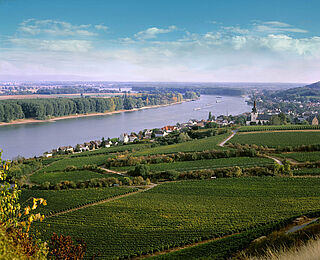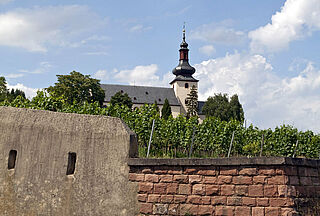Heerkretz
Kendte vinmarker
Heerkretz - Top vineyard in "Rheinhessen's Switzerland"
The western fringe of Germany's largest wine-growing region, Rheinhessen, takes in the steep hillsides and forested summits of "Rheinhessen's Switzerland" - a little-known circle of wine villages fanning out south of Wöllstein (southeast of Bad Kreuznach/Nahe).
Its proximity to the neighboring wine region, the Nahe, is reflected in its mix of forests (rare in Rheinhessen) and vine-clad slopes, as well as its geological makeup. The area lies in the western portion the ”Mainz Basin,” a subtropical Tertiary sea some 38 to 12 million years ago. The sediments and fossils left behind when the water receded provide a fascinating look at the area’s geological past. In addition, numerous artifacts from the Neolithic period, Bronze Age, as well as Celtic and Roman times, have been unearthed in the vicinity of this month’s famous vineyard.
“Heerkretz” is a first-rate hillside vineyard (partially terraced with dry stone walls) that slopes upward from an old “Heerstrasse” (literally, a road used by military forces, probably dating from Roman times, but also used by troops during the Napoleonic era). It stretches over a broad hill southwest of Siefersheim, extending west to neighboring Neu-Bamberg (both towns share the site name), in a winding course in which it faces east, south and west. Numerous hollows or small basins on the hillside also account for multiple exposures and help protect the vines from cold winds. The vineyards lie at heights ranging from 160 to 260 meters, making the site one of the highest in Rheinhessen.
In all, the site is very stony, with loamy soils in the lower and middle portions of the hill (sometimes mixed with sand), and shallower, stonier soils higher up the slope. Quartz crystals, feldspar and mica embedded in weathered porphyry and dark-colored melaphyre predominate throughout the site – and lend the soil its reddish-yellowish color (iron is also present, as is a bit of copper). The dark color of the melaphyre stems from a lava flow from Bad Münster am Stein/Nahe and Neu-Bamberg, toward Siefersheim and Eckelsheim some 285 million years ago. It quickly cooled and formed rhyolite. Subsoils include “Rotliegendes” (reddish mixtures of clay, slate and sandstone) and sporadic deposits of shell-limestone (fossils from the region’s “seaside” past). Although the vineyard has a good water supply (underground springs at the bottom of the hill), the upper crust of the topsoil tends to quickly dry out, thus making it difficult to till – the soils have to be “scratched” (kratzen...kretz)...accounting for the latter portion of the site’s name.
Here, as in other steep sites throughout German wine country, many acres have been abandoned. Some are being replanted today by dedicated, young vintners. Overall, the site is some 56 ha/138 acres in size at this writing. This figure takes into account that several small sites were consolidated into Heerkretz when vineyard boundaries were redrawn in the context of the German wine law of 1971. The core parcels of Heerkretz – many on old stone terraces – comprise some 44 hectares/109 acres. Prime parcels are located in the middle, steep upper streches of the site, some 250 m above sea level. Midway up the hill is a landmark – the Ajaxturm, a tall brick tower with a legendary past (see below). Riesling is the primary grape variety in the Heerkretz site, particulary in the stony, upper stretches. Small amounts of Spätburgunder (Pinot Noir) and Gewürztraminer are also cultivated, as well as a bit of Frühburgunder (earlier-ripening cousin of Spätburgunder), Portugieser, Merlot, St. Laurent (red varietals) and Silvaner and Kerner.
Daniel Wagner, Weingut Wagner-Stempel in Siefersheim, has holdings in Heerkretz – part of his vineyards are at an altitude of more than 250 m, and recently he acquired parcels midway up the slope, near the Ajaxturm. He explains that wines grown in porphyry soils often have a flinty note on the nose. The predominantly acidic soil lends the wines a taut acidity and they are very mineral in character, perceptible on the palate as a light saltiness.
Tips for Tourists:
- The rugged landscape of Rheinhessen’s Switzerland offers hikers and cyclists an extensive network of trails and paths. Nature lovers can enjoy rare flora and fauna in the 40-ha/100-acre nature reserve on the plateau of the hills between Siefersheim and Neu-Bamberg, e.g. rare orchids, pasque flowers, steppe grasses and heath (“Neu-Bamberger Heide”).
- The 8-km/5-mile circular route that starts and ends In Siefersheim’s market square, Bänkelches–Route (alluding to the 15 little benches [Bänkelchen] en route), runs through the vineyards and enables one to discover both vines and herbs. The village also maintains a “Kräuterlehrpfad” (signposted herb path), where you can bone up on wild herbs used both medicinally and in the kitchen (guided tours are possible).
- Siefersheim’s wine festival is the last weekend of August – “Tage der offenen Weinkeller” (open house at all estates, with music, food and wine).
- On the road between Wonsheim and Neu-Bamberg, one can see the landmark “Ajaxturm” mid-way up the vine-covered slope. It is a tall brick tower topped by a battlement. A closer look reveals a stone statue of a dog in the battlement. It is all part of a legend that recounts a sad love story dating from the second half of the 19th century. A wealthy farmer’s son from Siefersheim and the miller’s daughter secretly met at this site and ultimately fell in love. The only witness to their meetings was the dog (named Ajax?) that accompanied them. The miller, who had had a dispute with the farmer, forbade his daughter from marrying the farmer’s son. Indeed, he married her off to a wine merchant in Wonsheim and soon thereafter, she died of a broken heart. The farmer’s son never married, but built the tower in memory of his sweetheart, and added the statue of the dog as a symbol of his eternal loyalty. So much for the legend.
- A less romantic version: many young men in the area were brick masons and had little or no work in winter. As such, they were put to work building the tower – a prestigious landmark for Siefersheim during a period of prosperity in the second half of the 19th century.
- Cultural & culinary events and art exhibitions take place in nearby Eckelsheim, in the Kulturhof. The mid-19th-century farm buildings (renovated) include an upscale restaurant, a small wine shop and an herb garden. Details below. The renovation of the Kulturhof was a major project to help rejuvenate the village of Eckesheim – and is viewed as a model in Rheinhessen. In summer, there are open-air cultural events at the ruins of the late Gothic church (1519) “Beller Kirche” south of town. For a walk through the vineyards (with wild herbs en route) follow the arrows along the “Wein- und Kräuterwanderweg” that opened in 2006.
- Neu-Bamberg is a picturesque wine village replete with steep alleys lined with old half-timbered houses, an impressive town gate (Kandelpforte) – a vestige of the medieval town wall, and overlooked by the ruins of an ancient (13th-century) castle. It is known for “Stein und Wein” (stone and wine)...typical for this part of Rheinhessen, where quarries and vineyards abound.
- Last but not least: the spa Bad Kreuznach is only a fifteen-minute drive from Siefersheim. Here, you can see numerous ancient artifacts from the area and well-preserved Roman floor mosaics in the Römerhalle museum. The city also has a number of excellent places to wine and dine and overnight, but our selection focuses on offerings in Rheinhessische Schweiz.
Where to Eat and Sleep:
- Siefersheim: The guest house at family-operated Weingut Wagner-Stempel has four double rooms and three holiday appartments. Each is individually, very tastefully furnished. No smoking permitted. Breakfast is served in the pretty, oleander-filled courtyard in summer, and in winter, in a breakfast room with an open fireplace. Four bicycles are available. Check www.wagner-stempel.de for details about rooms, events and the estate’s award-winning wines. In 2007, Daniel Wagner was named “rising star of the year” in the German wine guide Der Eichelmann, and in April, the estate was listed as one of the 100 best wine estates of Germany by the consumer magazine Stern. Wöllsteiner Strasse 10.
- Eckelsheim: Hotel Klosterhof is a bed & breakfast with individually furnished, modern rooms in renovated mid-18th-century buildings that once belonged to a Kloster (monastery). In all, Ute Meller and Thomas Fischer have one single and six double rooms, and one suite. No smoking. Drinks and snacks are served in the shady courtyard, and there is an eclectic little shop that sells home accessories, a bit of clothing and jewelry. Bicycles are availbable (€7/day). Closed Jan. through March. Residents of non-European Union countries can pay with MC or Visa. Hauptstrasse 15. www.klosterhof-eckelsheim.de
- Eckelsheim: Weingasthaus im Kulturhof. Carola and Axel Greiner extend a warm welcome and serve creative, seasonal dishes with a Mediterranean accent –or– simply stop in for a glass of local wine with light fare. There’s a small Vinothek (wine shop) in the cellar and an herb garden on the grounds. Closed Mon. and Tues. No lunch Sat. No smoking. No credit cards. Kirchstrasse 5. www.kulturhof-eckelsheim.de
- Wöllstein: Wöllsteiner Weinstube. For very tasty country cooking, head for Ute and Norbert Budick’s friendly wine restaurant in an old half-timbered farmhouse that they lovingly renovated (inviting courtyard for dining in summer). Some 20 local wines by the glass and very good list of bottled wines (local and German; some international selections). Closed Mon. No lunch. No credit cards. Eleonorenstrasse 32. www.woellsteinerweinstube.de
- Hackenheim (suburb 2 km SE of Bad Kreuznach): Metzlers Gasthof. Petra and Bernhard Metzler operate two eateries here – a first-class (1 Michelin star) restaurant and an upscale Weinstube. The menu for both is identical in several respects, but the Weinstube menu also includes heartier, regional specialties that are more moderate in price. Al fresco dining is possible, weather permitting. Closed mid-June to mid-August. Closed Mon. and Tues. No lunch at restaurant except Sunday. AE, MC. Hauptstrasse 69 (coming from Bad Kreuznach, via Mannheimer Strasse; from Autobahn 61, exit 52 [Gau Bickelheim] and proceed west toward Wöllstein, Volxheim, Hackenheim, Bad Kreuznach). www.metzlers-gasthof.de
Many thanks to Siefersheimer wine-growers Daniel and Cathrin Wagner, Weingut Wagner-Stempel, for answering countless questions about the site and surroundings, plus supplying photos. Thanks, too, to Neu-Bamberger wine-grower Otto Friess, Weingut Friess (www.weingut-friess.de), for additional information. P.S. If you’re in Neu-Bamberg, he suggests having a simple, hearty meal at the restaurant “Zur Rheinhessischen Schweiz” – it’s where the locals eat.


